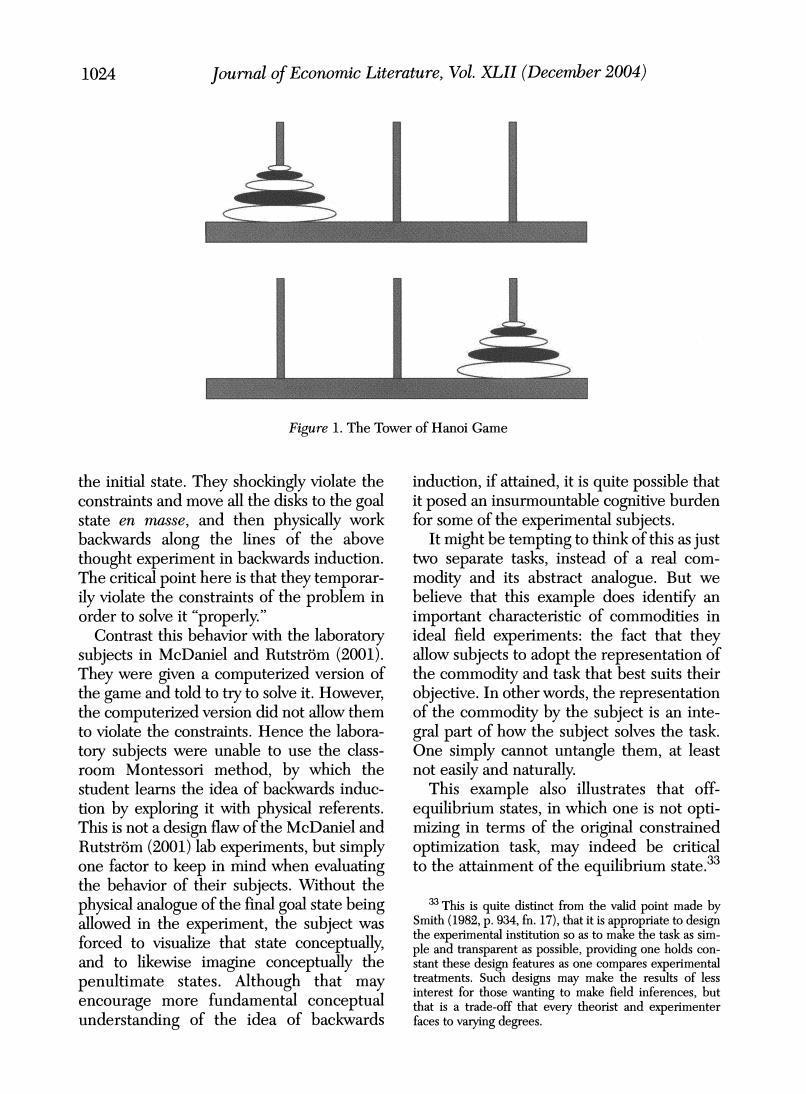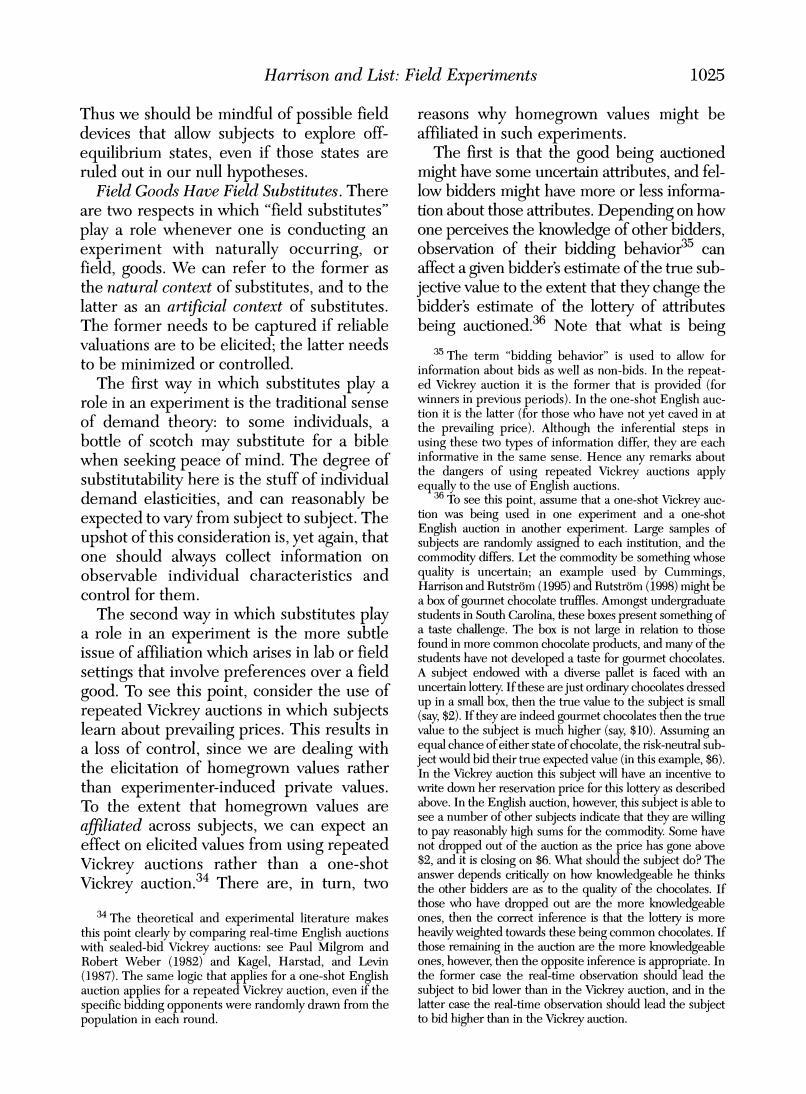
1024 Journal of Economic Literature,Vol.XLII(December 2004) Figure 1.The Tower of Hanoi Game the initial state.They shockingly violate the induction,if attained,it is quite possible that constraints and move all the disks to the goal it posed an insurmountable cog itive burden ng the lines for some of the experimental subjects of the above t in back It might be ing to think of this as just tho sepa tasks instead of a Th oint here is that th d its that this strac s exampl ide order to so ve it properly. characteristic dities in Contrast this with the laborato expenments the fact that the subjects in McDaniel and Rutstrom(2001 allow subjects to adopt the representation of They were given a computerized version of the commodity and task th nat best suits their the game and told to try to solve it.However, objective.In other words,the representation the computerized version did not allow them of the commodity by the subject is an inte- to violate the constraints.Hence the labora- gral part of how the subject solves the task. tory subjects were unable to use the class One simply cannot untangle them,at least room Montessori method,by which the not easily and naturally. student learns the idea of backwards induc. This example also illustrates that off- tion by exploring it with physical refe This is not a design flaw of the McDanieland mizing in terms of theor of t in m to ke d 3 oal stat being mith (92417)that itis we in the e subjec forced to visualize state conceptuall and tr and to likewise imagine conceptually the s as one penultimate states. Although that may ompare encourage more fundamental conceptual that ng to make field inferences,but every theorist a understanding of the idea of backwards faces to varying degrees

Harrison and List:Field Experiments 1025 Thus we should be mindful of possible field reasons why homegrown values might be devices that allow subjects to explore off- affiliated in such experiments. equilibrium states, even if those states are The first is that the good being auctioned ruled out in our null hypotheses. might have some uncertain attributes, and fel- Field Goods Have Field Substitutes. There low bidders might have more or less informa- are two respects in which "field substitutes' tion about those attributes. Depending on how play a role whenever one is conducting an one perceives the knowledge of other bidders, experiment with naturally occurring, or observation of their bidding behavior can field, goods. We can refer to the former as affect a given bidder's estimate of the true sub- the natural context of substitutes, and to the jective value to the extent that they change the latter as an artificial context of substitutes bidder's estimate of the lottery of attributes The former needs to be captured if reliable being auctioned.36 Note that what is being valuations are to be elicited: the latter needs to be minimized or controlled. 35 The term "bidding behavior" is used to allow for information about bids as well as non-bids. In the repeat- The first way in which substitutes play a ed Vickrey auction it is the former that is provided (for role in an experiment is the traditional sense winners in previous periods). In the one-shot English auc- of demand theory: to some individuals, a tion it is the latter (for those who have not yet caved in at the prevailing price). Although the inferential steps in bottle of scotch may substitute for a bible using these two types of information differ, they are each when seeking peace of mind. The degree of informative in the same sense. Hence any remarks about substitutability here is the stuff of individual the dangers of using repeated Vickrey auctions apply equally to the use of English auctions demand elasticities, and can reasonably be 36 To see this point, assume that a one-shot Vickrey auc- expected to vary from subject to subject. The tion was being used in one experiment and a one-shot upshot of this consideration is, yet again, that English auction in another experiment. Large samples of subjects are randomly assigned to each institution, and the one should always collect information on commodity differs. Let the commodity be something whose observable individual characteristics and quality is uncertain; an example used by Cummings, control for them. Harrison and Rutstrom(1995) and Rutstrom(1998) might be a box of gourmet chocolate truffles. Amongst undergraduate The second way in which substitutes play students in South Carolina, these boxes present something of a role in an experiment is the more subtle a taste challenge. The box is not large in relation to those issue of affiliation which arises in lab or field found in more common chocolate products, and many of the students have not developed a taste for gourmet chocolates. settings that involve preferences over a field A subject endowed with a diverse pallet is faced with an good. To see this point, consider the use of uncertain lottery. If these are just ordinary chocolates dressed repeated Vickrey auctions in which subjects up in a small box, then the true value to the subject is small (say, $2). If they are indeed gourmet chocolates then the true learn about prevailing prices. This results in value to the subject is much higher (say, $10). Assuming an a loss of control, since we are dealing with equal chance of either state of chocolate, the risk-neutral sub- the elicitation of homegrown values rather ject would bid their true expected value (in this example, $6) In the Vickrey auction this subject will have an incentive to than experimenter-induced private values. write down her reservation price for this lottery as described To the extent that homegrown values are above. In the English auction, however, this subject is able to see a number of other subjects indicate that they are willing affiliated across subjects,we can expect an to pay reasonably high sums for the commodity. Some have effect on elicited values from using repeated not dropped out of the auction as the price has gone above Vickrey auctions rather than a one-shot $2, and it is closing on $6. What should the subject do? The Vickrey auction.34 There are, in turn, two answer depends critically on how knowledgeable he thinks the other bidders are as to the quality of the chocolates. If those who have dropped out are the more knowledgeable 34 The theoretical and experimental literature makes ones, then the correct inference is that the lottery is more this point clearly by comparing real-time English auctions heavily weighted towards these being common chocolates. If with sealed-bid Vickrey auctions: see Paul Milgrom and those remaining in the auction are the more knowledgeable Robert Weber (1982) and Kagel, Harstad, and Levin ones, however, then the opposite inference is appropriate. In (1987). The same logic that applies for a one-shot English the former case the real-time observation should lead the auction applies for a repeated Vickrey auction, even if the subject to bid lower than in the Vickrey auction, and in the specific bidding opponents were randomly drawn from the latter case the real-time observation should lead the subject population in each round. to bid higher than in the Vickrey auction